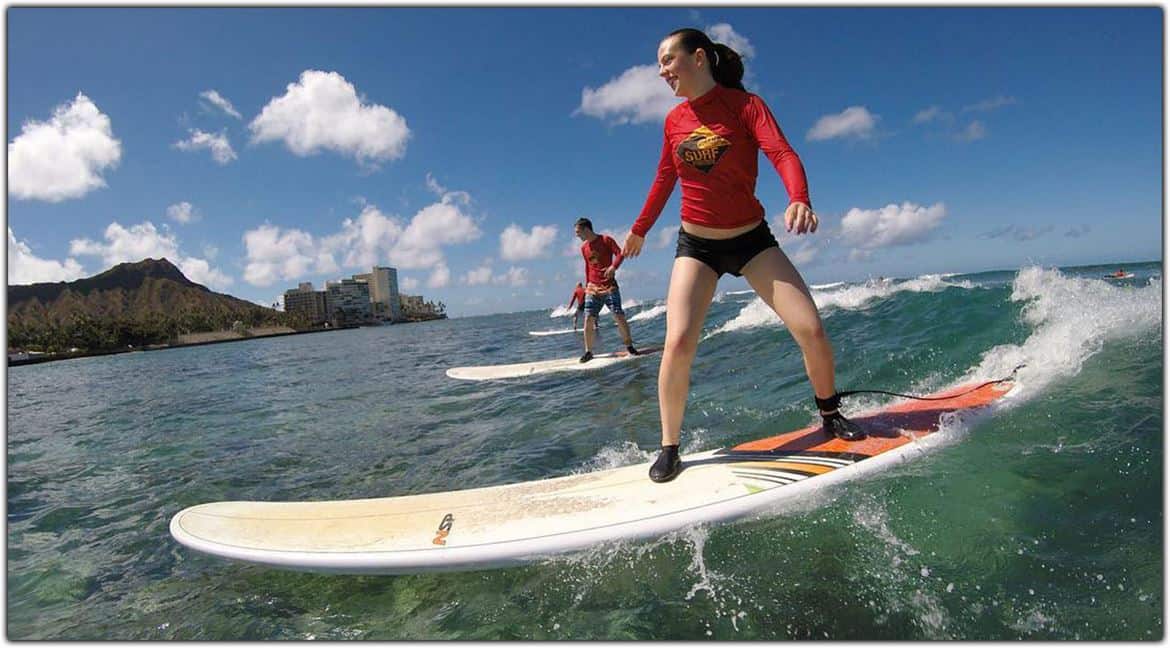There are over 23 million surfers in the world with more and more being added everyday. Everyone from little kids to your parents are braving the waves.
With so many benefits to the sport, it’s not hard to figure out why. It’s a great physical workout, great for your mind, and really just a lot of fun.
It can be addictive and once you find it, you’ll want everyone you know to try it.
But before you get started, you’ll need some lessons. So what should you expect on your first day?
In your first surf lesson, you’ll learn the basics of surfing through paddling, popping up and maneuvering a wave.
Your first surfing lesson will be all about the basics.
First you’ll learn about proper form and technique on land before trying it out in the water. You need to get a feel for what your body should be doing. It’s important to get a handle on this before going out into the waves.
On your first day, you’ll likely stay in the shallows and practice riding waves to shore, so you don’t need to worry about going way out to where you can’t stand.
Popping up quickly is tough in the beginning. It’ll take time to get the strength you need.
You may or may not stand up on a wave at your first lesson. Staying up on your board requires a lot of balance. Don’t feel discouraged if it takes you some time.
And if you do stand up, you’ll definitely wipe out at some point. Wiping out is part of learning to surf, so expect to fall, often. It’s part of the process and definitely not something to be embarrassed about.
But most of all, your first surf lesson will be fun!
In addition to these basics, here’s some tips to make the most of your first day on the water.
Stay Open
Learning a new skill can be challenging and learning to surf is no different. Go into it with an open mind and willingness to stay humble.
You won’t be a pro your first day, and neither should you be. Stay open to the process.
Not only are there tons of new physical skills you’re learning, but surfing also has a language all it’s own which can get confusing.
Ask your instructors questions, they’re there to help you and share their knowledge. Surfing should be fun and as long as you stick to the golden rule of keeping an open mind, you’ll be hooked in no time.
Have the Right Gear
To make the most of your first surf lesson, you definitely want to make sure you have the right gear. Although surfing can be minimalist, there’s still some things you want to consider.
Board
Choosing the right board is huge. It’s best to start out surfing with a longboard, 8 to 9 feet. Although heavy and sometimes clunky, a longboard provides better stability for a beginner than a shortboard.
They also have greater volume which equates to better buoyancy. Which will definitely help you out as you learn to surf.
Opt for a soft top or foam board. They’re soft and easier to manage during the beginning stage of surfing.
Clothing
You can surf in just your regular swimsuit, but you’ll be more comfortable if you try these.
Check the water temperature in the area you’ll be surfing. If it’s going to be too cold for you, buy or rent a wetsuit.
If you don’t need a wetsuit, definitely wear a rashguard and maybe boardshorts if your legs are exposed in your normal swimsuit.
You’ll be spending a lot of time laying face down on your board and these will keep your belly and legs from rubbing against it.
If you leave your skin exposed you’ll definitely end up with chafing. You don’t want to end your first session early because you didn’t wear the right protection.
Sun Protection
And most importantly, wear sunscreen, apply it often and make sure it’s above SPF 30.
It’s important to wear sunscreen all the time, but especially so out on the waves. The sun reflects off the water like a mirror, bouncing right back to you.
This extra sun can spell a painful sunburn after an hour or two in the ocean.
Stretch Before and Stretch After
To get the most out of your first lesson, definitely warm up beforehand. You’ll be using tons of muscles you don’t normally, so make sure you’re loose and ready to work.
If you go out cold, not only will you be more sore, you could easily pull a muscle or otherwise injure yourself. Be sure to hit all your major muscle groups, arms, shoulders, back, legs and glutes.
Try a sun salutation sequence from yoga to get the blood flowing and warm up all the necessary parts of the body.
And don’t forget to stretch after. It’s important to cool down after any activity but since you’re new to surfing, make time for a good after stretch.
Doing so will help prevent or lessen stiff muscles. You can even use the same sun salutation to cool down after your first surf session.

You’ll Be Sore
As mentioned, surfing is a full body workout and uses plenty of muscles that aren’t used to being engaged. So expect to be sore the next day.
This means you’re getting stronger! Stretching before and after will help, but can’t entirely prevent soreness. You can expect your arms to be exhausted as you’ll spend most of your time paddling, but also your core and lower body.
You may not realize it but popping up is a crazy core workout. Lifting your body from flat to standing in the blink of an eye requires all your ab muscles, so watch out when it hurts to laugh the next day.
Standing up and balancing engages your whole lower body, so you definitely don’t need to worry about leg day after your first surfing lesson.
To help combat your soreness, also stretch in the days after your lesson. It will help relieve your achy muscles and help you recover faster so you can get out again.
The more you practice, the less sore you’ll be over time. So just remember that when you wake up after that first day.
Know How to Swim
It may sound obvious, but make sure you can swim!
Yes, on your first day you’ll be sticking to shallow water, but you’ll still be doing plenty of swimming. Since surfing takes place in the water, it’s important to feel confident in your swimming ability.
Waves and their currents can be powerful so you need to know what you can handle. If you get stuck in a rip current, swim parallel to the shore until you get out, then swim to shore.
Brush up on your skills beforehand if you need it.
Reading the Wave
On your first lesson you’ll probably stick to whitewater waves, but it’s still important to know how to read a wave in order to properly catch one. First, the parts of the wave are the lip, shoulder, curl, white water, impact zone, tube and peak.
- Lip: The lip is the top part of the wave where it starts to break. The lip is where a lot of a wave’s power comes from
- Shoulder/ Face: The shoulder is the part of the wave that hasn’t broken yet. This is the area surfers usually ride, toward the unbroken part of a wave
- Pocket/ Curl: The curl, also known as the pocket, is the concave part of the shoulder.
- White water: White water is the part of a wave that’s already broken, aka, the white, foamy bit. As the easier part of a wave, this is where you’ll be riding as a beginner.
- Impact Zone: The impact zone is where the wave crashes onto itself. It’s where the wave is strongest and where you want to stay away from. This is the part of the wave that will cause you to wipe out.
- Tube/ Barrel: When a wave curves over itself creating a cylindrical tube. It’s the surfer dream to ride in the tube or barrel of a wave.
- Peak: The peak is the highest point of the wave. This is the part to look for when figuring out how a wave will break.
The next thing to know is which direction the wave is breaking, right or left. This is determined by the perspective of the person riding a wave.
So a right breaking wave moves toward the right of the person riding the wave. This would appear to be moving left if you were standing on the shore looking at the waves.
Waves start out as a lump on the water. Watch the way it grows and identify its peak.
Once you’ve identified the peak you can figure out which way the wave will go. The steepest angle on the side of the peak will determine the direction.
This will help you choose the right waves and know where to paddle to. It gets easier to read over time.
On your first lesson, you’ll mostly be looking for whitewater waves and practice riding into shore.
Related Questions
Are Surf Lessons Worth It?
If you really want to surf, investing in lessons is the way to go. While you technically can learn to surf on your own, knowing the rules and safety of surfing is paramount in the sport.
By taking surf lessons in the beginning you’ll learn the basics and how to prevent injuring yourself or others. Learning to ride waves in the ocean isn’t quite the same as learning to shoot a basket so it’s best to have the help of an experienced surfer to learn the ropes.
What Size Waves Are Good For a Beginner?
In general it’s best to stick with small waves as a beginner. Your focus ought to be on perfecting your paddle and pop up, versus catching big waves.
Stick with waves between 1-3 feet until you’re feeling confident.

